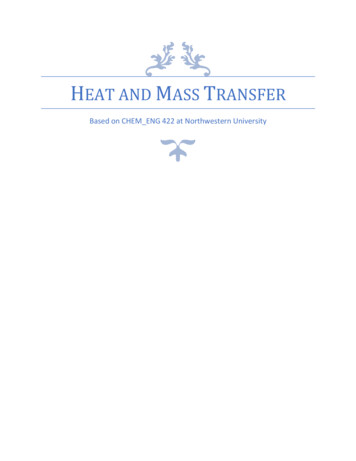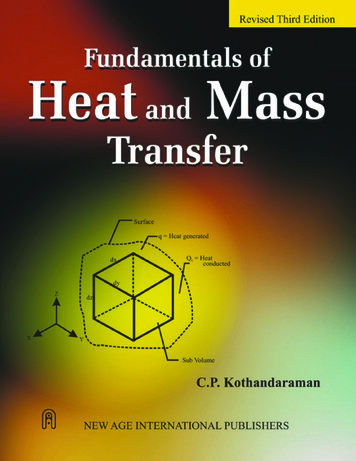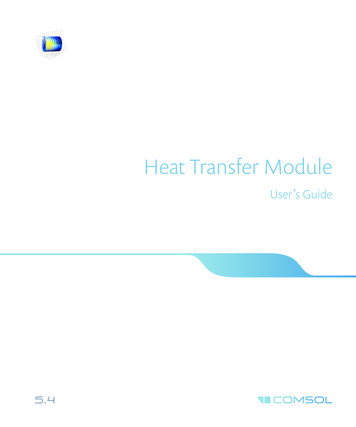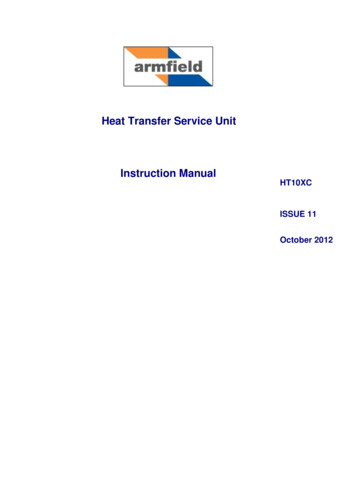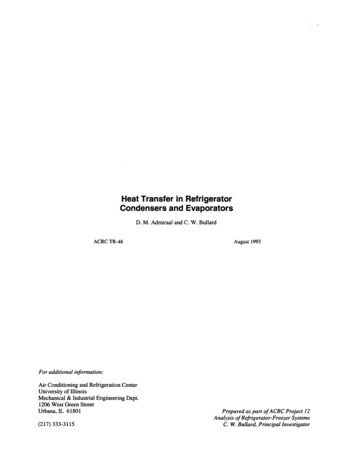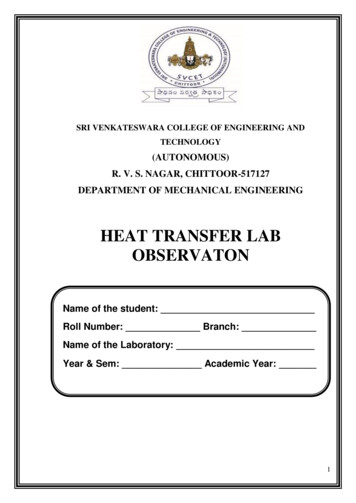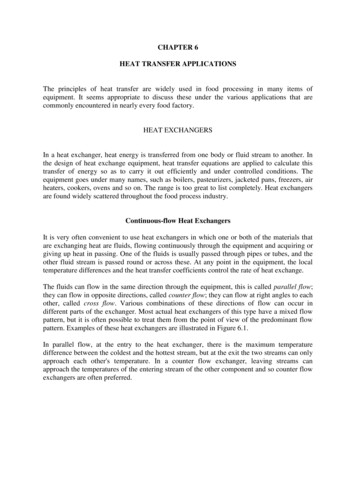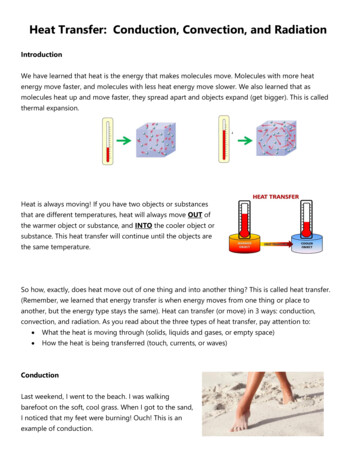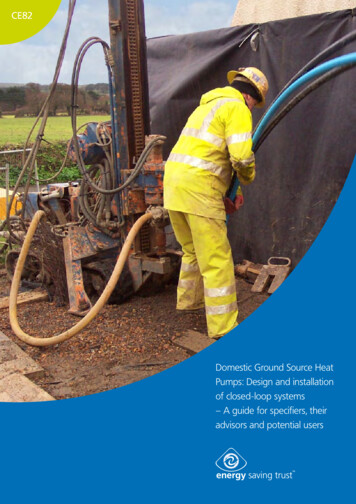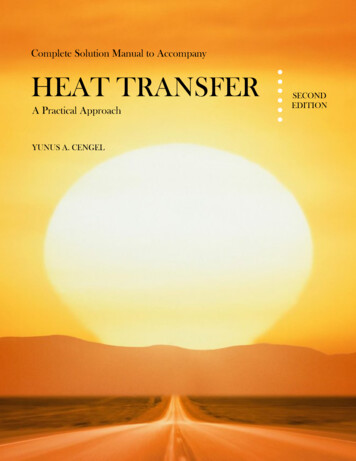
Transcription
Complete Solution Manual to AccompanyHEAT TRANSFERA Practical ApproachYUNUS A. CENGELSECONDEDITION
PrefaceThis manual is prepared as an aide to the instructors in correcting homework assignments, butit can also be used as a source of additional example problems for use in the classroom. Withthis in mind, all solutions are prepared in full detail in a systematic manner, using a wordprocessor with an equation editor. The solutions are structured into the following sections tomake it easy to locate information and to follow the solution procedure, as appropriate:Solution Assumptions Properties Analysis Discussion -The problem is posed, and the quantities to be found are stated.The significant assumptions in solving the problem are stated.The material properties needed to solve the problem are listed.The problem is solved in a systematic manner, showing all steps.Comments are made on the results, as appropriate.A sketch is included with most solutions to help the students visualize the physical problem,and also to enable the instructor to glance through several types of problems quickly, and tomake selections easily.Problems designated with the CDicon in the text are also solved withthe EES software, and electronic solutionscomplete with parametric studiesare available on the CD that accompanies the text. Comprehensive problems designated withthe computer-EES icon [pick one of the four given] are solved using the EES software, andtheir solutions are placed at the Instructor Manual section of the Online Learning Center(OLC) at www.mhhe.com/cengel. Access to solutions is limited to instructors only whoadopted the text, and instructors may obtain their passwords for the OLC by contacting theirMcGraw-Hill Sales Representative at http://www.mhhe.com/catalogs/rep/.Every effort is made to produce an error-free Solutions Manual. However, in a text ofthis magnitude, it is inevitable to have some, and we will appreciate hearing about them. Wehope the text and this Manual serve their purpose in aiding with the instruction of HeatTransfer, and making the Heat Transfer experience of both the instructors and students apleasant and fruitful one.We acknowledge, with appreciation, the contributions of numerous users of the firstedition of the book who took the time to report the errors that they discovered. All of theirsuggestions have been incorporated. Special thanks are due to Dr. Mehmet Kanoglu whochecked the accuracy of most solutions in this Manual.Yunus A. ÇengelJuly 2002
Chapter 1 Basics of Heat TransferChapter 1BASICS OF HEAT TRANSFERThermodynamics and Heat Transfer1-1C Thermodynamics deals with the amount of heat transfer as a system undergoes a process from oneequilibrium state to another. Heat transfer, on the other hand, deals with the rate of heat transfer as well asthe temperature distribution within the system at a specified time.1-2C (a) The driving force for heat transfer is the temperature difference. (b) The driving force for electriccurrent flow is the electric potential difference (voltage). (a) The driving force for fluid flow is the pressuredifference.1-3C The caloric theory is based on the assumption that heat is a fluid-like substance called the "caloric"which is a massless, colorless, odorless substance. It was abandoned in the middle of the nineteenthcentury after it was shown that there is no such thing as the caloric.1-4C The rating problems deal with the determination of the heat transfer rate for an existing system at aspecified temperature difference. The sizing problems deal with the determination of the size of a system inorder to transfer heat at a specified rate for a specified temperature difference.1-5C The experimental approach (testing and taking measurements) has the advantage of dealing with theactual physical system, and getting a physical value within the limits of experimental error. However, thisapproach is expensive, time consuming, and often impractical. The analytical approach (analysis orcalculations) has the advantage that it is fast and inexpensive, but the results obtained are subject to theaccuracy of the assumptions and idealizations made in the analysis.1-6C Modeling makes it possible to predict the course of an event before it actually occurs, or to studyvarious aspects of an event mathematically without actually running expensive and time-consumingexperiments. When preparing a mathematical model, all the variables that affect the phenomena areidentified, reasonable assumptions and approximations are made, and the interdependence of thesevariables are studied. The relevant physical laws and principles are invoked, and the problem is formulatedmathematically. Finally, the problem is solved using an appropriate approach, and the results areinterpreted.1-7C The right choice between a crude and complex model is usually the simplest model which yieldsadequate results. Preparing very accurate but complex models is not necessarily a better choice since suchmodels are not much use to an analyst if they are very difficult and time consuming to solve. At theminimum, the model should reflect the essential features of the physical problem it represents.1-1
Chapter 1 Basics of Heat TransferHeat and Other Forms of Energy1-8C The rate of heat transfer per unit surface area is called heat flux q& . It is related to the rate of heattransfer by Q& q&dA .A1-9C Energy can be transferred by heat, work, and mass. An energy transfer is heat transfer when itsdriving force is temperature difference.1-10C Thermal energy is the sensible and latent forms of internal energy, and it is referred to as heat indaily life.1-11C For the constant pressure case. This is because the heat transfer to an ideal gas is mCpΔT at constantpressure and mCpΔT at constant volume, and Cp is always greater than Cv.1-12 A cylindrical resistor on a circuit board dissipates 0.6 W of power. The amount of heat dissipated in24 h, the heat flux, and the fraction of heat dissipated from the top and bottom surfaces are to bedetermined.Assumptions Heat is transferred uniformly from all surfaces.Analysis (a) The amount of heat this resistor dissipates during a 24-hour period isQ Q& Δt (0.6 W)(24 h) 14.4 Wh 51.84 kJ (since 1 Wh 3600 Ws 3.6 kJ)Q&(b) The heat flux on the surface of the resistor isAs 2q& s πD 24 πDL 2π (0.4 cm) 24 π (0.4 cm)(1.5 cm) 0.251 1.885 2.136 cm 2Resistor0.6 WQ&0.60 W 0.2809 W/cm 2As 2.136 cm 2(c) Assuming the heat transfer coefficient to be uniform, heat transfer is proportional to thesurface area. Then the fraction of heat dissipated from the top and bottom surfaces of theresistor becomesQtop baseQtotal Atop baseAtotal 0.251 0.118 or (11.8%)2136.Discussion Heat transfer from the top and bottom surfaces is small relative to that transferred from the sidesurface.1-2
Chapter 1 Basics of Heat Transfer1-13E A logic chip in a computer dissipates 3 W of power. The amount heat dissipated in 8 h and the heatflux on the surface of the chip are to be determined.Assumptions Heat transfer from the surface is uniform.Analysis (a) The amount of heat the chip dissipates during an 8-hour period isQ Q& Δt ( 3 W)(8 h) 24 Wh 0.024 kWhLogic chipQ& 3 W(b) The heat flux on the surface of the chip isQ&3W 37.5 W/in 2q& s As 0.08 in 21-14 The filament of a 150 W incandescent lamp is 5 cm long and has a diameter of 0.5 mm. The heat fluxon the surface of the filament, the heat flux on the surface of the glass bulb, and the annual electricity costof the bulb are to be determined.Assumptions Heat transfer from the surface of the filament and the bulb of the lamp is uniform .Analysis (a) The heat transfer surface area and the heat flux on the surface of the filament areAs πDL π (0.05 cm)(5 cm) 0.785 cm 2q& s Q&150 W 191 W/cm 2 1.91 10 6 W/m 2As 0.785 cm 2Q&Lamp150 W(b) The heat flux on the surface of glass bulb isAs πD 2 π (8 cm) 2 201.1 cm 2q& s Q&150 W 0.75 W/cm 2 7500 W/m 2As 201.1 cm 2(c) The amount and cost of electrical energy consumed during a one-year period isElectricity Consumption Q& Δt ( 015. kW)(365 8 h / yr) 438 kWh / yrAnnual Cost (438 kWh / yr)( 0.08 / kWh) 35.04 / yr1-15 A 1200 W iron is left on the ironing board with its base exposed to the air. The amount of heat theiron dissipates in 2 h, the heat flux on the surface of the iron base, and the cost of the electricity are to bedetermined.Assumptions Heat transfer from the surface is uniform.IronAnalysis (a) The amount of heat the iron dissipates during a 2-h period is1200 WQ Q& Δt (1.2 kW)(2 h) 2.4 kWh(b) The heat flux on the surface of the iron base isQ& base ( 0.9)(1200 W) 1080 WQ&1080 Wq& base 72,000 W / m 2Abase 0.015 m 2(c) The cost of electricity consumed during this period isCost of electricity (2.4 kWh) ( 0.07 / kWh) 0.171-3
Chapter 1 Basics of Heat Transfer1-16 A 15 cm 20 cm circuit board houses 120 closely spaced 0.12 W logic chips. The amount of heatdissipated in 10 h and the heat flux on the surface of the circuit board are to be determined.Assumptions 1 Heat transfer from the back surface of the board is negligible. 2 Heat transfer from the frontsurface is uniform.Analysis (a) The amount of heat this circuit board dissipates during a 10-h period isQ& (120)(0.12 W) 14.4 WChips,0.12WQ Q& Δt (0.0144 kW)(10 h) 0.144 kWhQ&(b) The heat flux on the surface of the circuit board isAs (0.15 m )(0.2 m ) 0.03 m 2q& s Q&14.4 W 480 W/m 2As 0.03 m 215 cm20 cm1-17 An aluminum ball is to be heated from 80 C to 200 C. The amount of heat that needs to betransferred to the aluminum ball is to be determined.Assumptions The properties of the aluminum ball are constant.Properties The average density and specific heat of aluminum aregiven to be ρ 2,700 kg/m3 and C p 0.90 kJ/kg. C.MetalballAnalysis The amount of energy added to the ball is simply the change in itsinternal energy, and is determined fromEtransfer ΔU mC (T2 T1)wherem ρV π6ρD3 π6(2700 kg / m3 )(015. m)3 4.77 kgESubstituting,Etransfer (4.77 kg)(0.90 kJ / kg. C)(200 - 80) C 515 kJTherefore, 515 kJ of energy (heat or work such as electrical energy) needs to betransferred to the aluminum ball to heat it to 200 C.1-18 The body temperature of a man rises from 37 C to 39 C during strenuous exercise. The resultingincrease in the thermal energy content of the body is to be determined.Assumptions The body temperature changes uniformly.Properties The average specific heat of the human body is given to be 3.6kJ/kg. C.Analysis The change in the sensible internal energy content of the body as aresult of the body temperature rising 2 C during strenuous exercise isΔU mCΔT (70 kg)(3.6 kJ/kg. C)(2 C) 504 kJ1-4
Chapter 1 Basics of Heat Transfer1-19 An electrically heated house maintained at 22 C experiences infiltration losses at a rate of 0.7 ACH.The amount of energy loss from the house due to infiltration per day and its cost are to be determined.Assumptions 1 Air as an ideal gas with a constant specific heats at room temperature. 2 The volumeoccupied by the furniture and other belongings is negligible. 3 The house is maintained at a constanttemperature and pressure at all times. 4 The infiltrating air exfiltrates at the indoors temperature of 22 C.Properties The specific heat of air at room temperature is C p 1.007 kJ/kg. C (Table A-15).Analysis The volume of the air in the house isV ( floor space)(height) (200 m2 )(3 m) 600 m3Noting that the infiltration rate is 0.7 ACH (air changes per hour) andthus the air in the house is completely replaced by the outdoor air0.7 24 16.8 times per day, the mass flow rate of air through thehouse due to infiltration isP V&P (ACH V house )m& air o air oRToRTo 3(89.6 kPa)(16.8 600 m / day)(0.287 kPa.m 3 /kg.K)(5 273.15 K)0.7 ACH22 CAIR5 C 11,314 kg/dayNoting that outdoor air enters at 5 C and leaves at 22 C, the energy loss of this house per day isQ& m& C (T T)infiltairpindoorsoutdoors (11,314 kg/day)(1.007 kJ/kg. C)(22 5) C 193,681 kJ/day 53.8 kWh/dayAt a unit cost of 0.082/kWh, the cost of this electrical energy lost by infiltration isEnegy Cost (Energy used)(Unit cost of energy) (53.8 kWh/day)( 0.082/kWh) 4.41/day1-5
Chapter 1 Basics of Heat Transfer1-20 A house is heated from 10 C to 22 C by an electric heater, and some air escapes through the cracks asthe heated air in the house expands at constant pressure. The amount of heat transfer to the air and its costare to be determined.Assumptions 1 Air as an ideal gas with a constant specific heats at room temperature. 2 The volumeoccupied by the furniture and other belongings is negligible. 3 The pressure in the house remains constantat all times. 4 Heat loss from the house to the outdoors is negligible during heating. 5 The air leaks out at22 C.Properties The specific heat of air at room temperature is C p 1.007kJ/kg. C (Table A-15).Analysis The volume and mass of the air in the house areV ( floor space)(height) (200 m2 )(3 m) 600 m3PV(1013. kPa)(600 m3 )m 747.9 kgRT (0.287 kPa.m3 / kg.K)(10 273.15 K)22 C10 CAIRNoting that the pressure in the house remains constant during heating, the amount of heat that must betransferred to the air in the house as it is heated from 10 to 22 C is determined to beQ mC p (T 2 T1 ) (747.9 kg)(1.007 kJ/kg. C)(22 10 ) C 9038 kJNoting that 1 kWh 3600 kJ, the cost of this electrical energy at a unit cost of 0.075/kWh isEnegy Cost (Energy used)(Unit cost of energy) (9038 / 3600 kWh)( 0.075/kWh) 0.19Therefore, it will cost the homeowner about 19 cents to raise the temperature in his house from 10 to 22 C.1-21E A water heater is initially filled with water at 45 F. The amount of energy that needs to betransferred to the water to raise its temperature to 140 F is to be determined.Assumptions 1 Water is an incompressible substance with constant specific heats at room temperature. 2No water flows in or out of the tank during heating.Properties The density and specific heat of water are given to be 62 lbm/ft3 and 1.0 Btu/lbm. F.Analysis The mass of water in the tank is 1 ft 3 497.3 lbmm ρV (62 lbm/ft 3 )(60 gal) 7.48 gal Then, the amount of heat that must be transferred to the water in thetank as it is heated from 45 to140 F is determined to beQ mC (T2 T1 ) (497.3 lbm)(1.0 Btu/lbm. F)(140 45) F 47,250 Btu140 F45 FWaterThe First Law of Thermodynamics1-22C Warmer. Because energy is added to the room air in the form of electrical work.1-23C Warmer. If we take the room that contains the refrigerator as our system, we will see that electricalwork is supplied to this room to run the refrigerator, which is eventually dissipated to the room as wasteheat.1-6
Chapter 1 Basics of Heat Transfer1-24C Mass flow rate m& is the amount of mass flowing through a cross-section per unit time whereas thevolume flow rate V& is the amount of volume flowing through a cross-section per unit time. They arerelated to each other by m& ρV& where ρ is density.1-25 Two identical cars have a head-on collusion on a road, and come to a complete rest after the crash.The average temperature rise of the remains of the cars immediately after the crash is to be determined.Assumptions 1 No heat is transferred from the cars. 2 All the kinetic energy of cars is converted to thermalenergy.Properties The average specific heat of the cars is given to be 0.45 kJ/kg. C.Analysis We take both cars as the system. This is a closed system since it involves a fixed amount of mass(no mass transfer). Under the stated assumptions, the energy balance on the system can be expressed asE E1in424out3ΔE system14243 Net energy transferby heat, work, and massChange in internal, kinetic,potential, etc. energies0 ΔU cars ΔKE cars0 (mCΔT ) cars [m(0 V 2 ) / 2]carsThat is, the decrease in the kinetic energy of the cars must be equal to the increase in their internal energy.Solving for the velocity and substituting the given quantities, the temperature rise of the cars becomesΔT mV 2 / 2 V 2 / 2 (90,000 / 3600 m/s) 2 / 2 1 kJ/kg 0.69 C mCC0.45 kJ/kg. C 1000 m 2 /s 2 1-26 A classroom is to be air-conditioned using window air-conditioning units. The cooling load is due topeople, lights, and heat transfer through the walls and the windows. The number of 5-kW window airconditioning units required is to be determined.Assumptions There are no heat dissipating equipment (such as computers, TVs, or ranges) in the room.Analysis The total cooling load of the room is determined fromQ& Q& Q& Q&coolingwhereQ&lightslightspeopleheat gain 10 100 W 1 kWQ& people 40 360kJ/h 14,400 kJ/h 4kWRoom15,000 kJ/hQ& heat gain 15,000 kJ/h 4.17 kWSubstituting,Q& cooling 1 4 4.17 9.17 kWThus the number of air-conditioning units required is9.17 kW 1.83 2 units5 kW/unit1-740 people10 bulbs·Qcool
Chapter 1 Basics of Heat Transfer1-27E The air in a rigid tank is heated until its pressure doubles. The volume of the tank and the amount ofheat transfer are to be determined.Assumptions 1 Air is an ideal gas since it is at a high temperature and low pressure relative to its criticalpoint values of -141 C and 3.77 MPa. 2 The kinetic and potential energy changes are negligible,Δpe Δke 0 . 3 Constant specific heats at room temperature can be used for air. This assumption resultsin negligible error in heating and air-conditioning applications.Properties The gas constant of air is R 0.3704 psia.ft3/lbm.R 0.06855 Btu/lbm.R (Table A-1).Analysis (a) We take the air in the tank as our system. This is a closed system since no mass enters orleaves. The volume of the tank can be determined from the ideal gas relation,V 3mRT1 (20lbm)(0.3704 psia ft /lbm R)(80 460R) 80.0ft 3P150psia(b) Under the stated assumptions and observations, the energy balance becomesE E1in424out3 Net energy transferby heat, work, and massΔE system14243Change in internal, kinetic,potential, etc. energiesQin ΔU Qin m(u2 u1 ) mCv (T2 T1 )The final temperature of air isPVPV1 2 T1T2T2 P2T1 2 (540 R) 1080 RP1The specific heat of air at the average temperature of Tave (540 1080)/2 810 R 350 F isCv,ave Cp,ave – R 0.2433 - 0.06855 0.175 Btu/lbm.R. Substituting,Q (20 lbm)( 0.175 Btu/lbm.R)(1080 - 540) R 1890 BtuAir20 lbm50 psia80 FQ1-8
Chapter 1 Basics of Heat Transfer1-28 The hydrogen gas in a rigid tank is cooled until its temperature drops to 300 K. The final pressure inthe tank and the amount of heat transfer are to be determined.Assumptions 1 Hydrogen is an ideal gas since it is at a high temperature and low pressure relative to itscritical point values of -240 C and 1.30 MPa. 2 The kinetic and potential energy changes are negligible,Δke Δpe 0 .Properties The gas constant of hydrogen is R 4.124 kPa.m3/kg.K (Table A-1).Analysis (a) We take the hydrogen in the tank as our system. This is a closed system since no mass entersor leaves. The final pressure of hydrogen can be determined from the ideal gas relation,P1V P2VT300 K P2 2 P1 (250 kPa) 178.6 kPaT1T2T1420 K(b) The energy balance for this system can be expressed asE E ΔE system1in424out314243Net energy transferby heat, work, and massChange in internal, kinetic,potential, etc. energies Qout ΔUQout ΔU m(u2 u1 ) mCv (T1 T2 )wherem (250 kPa)(1.0 m 3 )P1V 0.1443 kgRT1 (4.124 kPa m 3 /kg K)(420 K)H2250 kPa420 KQUsing the Cv ( Cp – R) 14.516 – 4.124 10.392 kJ/kg.K value at the average temperature of 360 K andsubstituting, the heat transfer is determined to beQout (0.1443 kg)(10.392 kJ/kg·K)(420 - 300)K 180.0 kJ1-9
Chapter 1 Basics of Heat Transfer1-29 A resistance heater is to raise the air temperature in the room from 7 to 25 C within 20 min. Therequired power rating of the resistance heater is to be determined.Assumptions 1 Air is an ideal gas since it is at a high temperature and low pressure relative to its criticalpoint values of -141 C and 3.77 MPa. 2 The kinetic and potential energy changes are negligible,Δke Δpe 0 . 3 Constant specific heats at room temperature can be used for air. This assumption resultsin negligible error in heating and air-conditioning applications. 4 Heat losses from the room are negligible.Properties The gas constant of air is R 0.287 kPa.m3/kg.K (Table A-1). Also, Cp 1.007 kJ/kg·K for airat room temperature (Table A-15).Analysis We observe that the pressure in the room remains constant during this process. Therefore, someair will leak out as the air expands. However, we can take the air to be a closed system by considering theair in the room to have undergone a constant pressure expansion process. The energy balance for thissteady-flow system can be expressed asE E ΔE system1in424out314243Net energy transferby heat, work, and massChange in internal, kinetic,potential, etc. energiesWe ,in Wb ΔUWe,in ΔH m(h2 h1 ) mC p (T2 T1 )or,W&e,in Δt mC p , ave (T2 T1 )4 5 6 m37 CThe mass of air isV 4 5 6 120 m3PV(100 kPa)(120 m3 )m 1 149.3 kgRT1 (0.287 kPa m3 / kg K)(280 K)WeUsing Cp value at room temperature, the power rating of the heater becomesW& (149.3 kg)(1.007 kJ/kg o C)(25 7) o C/(15 60 s) 3.01 kWe,in1-10AIR
Chapter 1 Basics of Heat Transfer1-30 A room is heated by the radiator, and the warm air is distributed by a fan. Heat is lost from the room.The time it takes for the air temperature to rise to 20 C is to be determined.Assumptions 1 Air is an ideal gas since it is at a high temperature and low pressure relative to its criticalpoint values of -141 C and 3.77 MPa. 2 The kinetic and potential energy changes are negligible,Δke Δpe 0 . 3 Constant specific heats at room temperature can be used for air, Cp 1.007 and Cv 0.720 kJ/kg·K. This assumption results in negligible error in heating and air-conditioning applications. 4The local atmospheric pressure is 100 kPa.Properties The gas constant of air is R 0.287 kPa.m3/kg.K (Table A-1). Also, Cp 1.007 kJ/kg·K for airat room temperature (Table A-15).Analysis We take the air in the room as the system. This is a closed system since no mass crosses thesystem boundary during the process. We observe that the pressure in the room remains constant during thisprocess. Therefore, some air will leak out as the air expands. However we can take the air to be a closedsystem by considering the air in the room to have undergone a constant pressure process. The energybalance for this system can be expressed asE E ΔE system1in424out314243Net energy transferby heat, work, and massChange in internal, kinetic,potential, etc. energiesQin We,in Wb Qout ΔU(Q& in W&e,in Q& out ) Δt ΔH m(h2 h1 ) mC p (T2 T1 )5,000 kJ/hROOMThe mass of air isV 4 5 7 140 m3m PV(100 kPa)(140 m3 )1 172.4 kgRT1 (0.287 kPa m3 / kg K)(283 K)Using the Cp value at room temperature,4m 5m 7mSteam·Wpw[(10,000 5000)/3600 kJ/s 0.1 kJ/s]Δt (172.4 kg)(1.007 kJ/kg C)(20 10) CIt yieldsΔt 1163 s1-1110,000 kJ/h
Chapter 1 Basics of Heat Transfer1-31 A student living in a room turns his 150-W fan on in the morning. The temperature in the room whenshe comes back 10 h later is to be determined.Assumptions 1 Air is an ideal gas since it is at a high temperature and low pressure relative to its criticalpoint values of -141 C and 3.77 MPa. 2 The kinetic and potential energy changes are negligible,Δke Δpe 0 . 3 Constant specific heats at room temperature can be used for air. This assumption resultsin negligible error in heating and air-conditioning applications. 4 All the doors and windows are tightlyclosed, and heat transfer through the walls and the windows is disregarded.Properties The gas constant of air is R 0.287 kPa.m3/kg.K (Table A-1). Also, Cp 1.007 kJ/kg·K for airat room temperature (Table A-15) and Cv Cp – R 0.720 kJ/kg·K.Analysis We take the room as the system. This is a closed system since the doors and the windows are saidto be tightly closed, and thus no mass crosses the system boundary during the process. The energy balancefor this system can be expressed asΔE systemE E 1in424out314243Net energy transferby heat, work, and massChange in internal, kinetic,potential, etc. energies(insulated)ROOMWe,in ΔUWe,in m(u2 u1 ) mCv (T2 T1 )The mass of air is4m 6m 6mV 4 6 6 144 m3m PV(100 kPa)(144 m3 )1 174.2 kgRT1 (0.287 kPa m3 / kg K)(288 K)The electrical work done by the fan isW W& Δt (0.15 kJ / s)(10 3600 s) 5400 kJeeSubstituting and using Cv value at room temperature,5400 kJ (174.2 kg)(0.720 kJ/kg. C)(T2 - 15) CT2 58.1 C1-12·We
Chapter 1 Basics of Heat Transfer1-32E A paddle wheel in an oxygen tank is rotated until the pressure inside rises to 20 psia while someheat is lost to the surroundings. The paddle wheel work done is to be determined.Assumptions 1 Oxygen is an ideal gas since it is at a high temperature and low pressure relative to itscritical point values of -181 F and 736 psia. 2 The kinetic and potential energy changes are negligible,Δke Δpe 0 . 3 The energy stored in the paddle wheel is negligible. 4 This is a rigid tank and thus itsvolume remains constant.Properties The gas constant of oxygen is R 0.3353 psia.ft3/lbm.R 0.06206 Btu/lbm.R (Table A-1E).Analysis We take the oxygen in the tank as our system. This is a closed system since no mass enters orleaves. The energy balance for this system can be expressed asE E ΔE system1in424out314243Net energy transferby heat, work, and massChange in internal, kinetic,potential, etc. energiesWpw,in Qout ΔUWpw ,in Qout m(u2 u1 ) Qout mCv (T2 T1 )The final temperature and the number of moles of oxygen arePVPV1 2T1T2m T2 20 psiaP2(540 R) 735 RT1 14.7 psiaP1O214.7 psia80 F20 Btu(14.7 psia)(10 ft 3 )PV1 0.812 lbmRT1 (0.3353 psia ft 3 / lbmol R)(540 R)The specific heat ofoxygen at the average temperature of Tave (735 540)/2 638 R 178 F isCv,ave Cp – R 0.2216-0.06206 0.160 Btu/lbm.R. Substituting,Wpw,in (20 Btu) (0.812 lbm)(0160 Btu/lbm.R)(735 - 540) Btu/lbmol 45.3 BtuDiscussion Note that a “cooling” fan actually causes the internal temperature of a confined space to rise. Infact, a 100-W fan supplies a room as much energy as a 100-W resistance heater.1-33 It is observed that the air temperature in a room heated by electric baseboard heaters remains constanteven though the heater operates continuously when the heat losses from the room amount to 7000 kJ/h. Thepower rating of the heater is to be determined.Assumptions 1 Air is an ideal gas since it is at a high temperature and low pressure relative to its criticalpoint values of -141 C and 3.77 MPa. 2 The kinetic and potential energy changes are negligible,Δke Δpe 0 . 3 We the temperature of the room remains constant during this process.Analysis We take the room as the system. The energy balance in this case reduces to ΔE systemE E1in424out314243Net energy transferby heat, work, and massChange in internal, kinetic,potential, etc. energiesWe,in Qout ΔU 0We,in Qoutsince ΔU mCvΔT 0 for isothermal processes of ideal gases. Thus, 1kW 1.94 kWW& e,in Q& out 7000kJ/h 3600kJ/h AIRWe1-13
Chapter 1 Basics of Heat Transfer1-34 A hot copper block is dropped into water in an insulated tank. The final equilibrium temperature of thetank is to be determined.Assumptions 1 Both the water and the copper block are incompressible substances with constant specificheats at room temperature. 2 The system is stationary and thus the kinetic and potential energy changes arezero, ΔKE ΔPE 0 and ΔE ΔU . 3 The system is well-insulated and thus there is no heat transfer.Properties The specific heats of water and the copper block at room temperature are Cp, water 4.18kJ/kg· C and Cp, Cu 0.386 kJ/kg· C (Tables A-3 and A-9).Analysis We observe that the volume of a rigid tank is constant We take the entire contents of the tank,water copper block, as the system. This is a closed system since no mass crosses the system boundaryduring the process. The energy balance on the system can be expressed asE Eout1in4243 Net energy transferby heat, work, and massΔEsystem124 43WATERChange in internal, kinetic,potential, etc. energies0 ΔUCopperΔU Cu ΔU water 0or,[mC (T2 T1 )]Cu [mC (T2 T1 )]water 0Using specific heat values for copper and liquid water at room temperature and substituting,(50 kg)(0.386 kJ/kg C)(T2 70) C (80 kg)(4.18 kJ/kg C)(T2 25) C 0T2 27.5 C1-35 An iron block at 100 C is brought into contact with an aluminum block at 200 C in an insulatedenclosure. The final equilibrium temperature of the combined system is to be determined.Assumptions 1 Both the iron and aluminum block are incompressible substances with constant specificheats. 2 The system is stationary and thus the kinetic and potential energy changes are zero,ΔKE ΔPE 0 and ΔE ΔU . 3 The system is well-insulated and thus there is no heat transfer.Properties The specific heat of iron is given in Table A-3 to be 0.45 kJ/kg. C, which is the value at roomtemperature. The specific heat of aluminum at 450 K (which is somewhat below 200 C 473 K) is 0.973kJ/kg. C.Analysis We take the entire contents of the enclosure iron aluminum blocks, as the system. This is aclosed system since no mass crosses the system boundary during the process. The energy balance on thesystem can be expressed asE Eout1in4243 Net energy transferby heat, work, and massΔEsystem124 43Change in internal, kinetic,potential, etc. energies0 ΔU20 kgAlΔU iron ΔU Al 0or,20 kgiron[mC (T2 T1 )]iron [mC (T2 T1 )]Al 0Substituting,(20 kg)(0.450 kJ / kg o C)(T2 100)o C (20 kg)(0.973 kJ / kg o C)(T2 200)o C 0T2 168 C1-36 An unknown mass of iron is dropped into water in an insulated tank while being stirred by a 200-Wpaddle wheel. Thermal equilibrium is established after 25 min.
Chapter 1 Basics of Heat Transfer 1-4 1-16 A 15 cm 20 cm circuit board houses 120 closely spaced 0.12 W logic chips. The amount of heat dissipated in 10 h and the heat flux on the surface of the circuit board are to be determined. Assumptions 1 Heat transfer from the back surface of the board is negl

